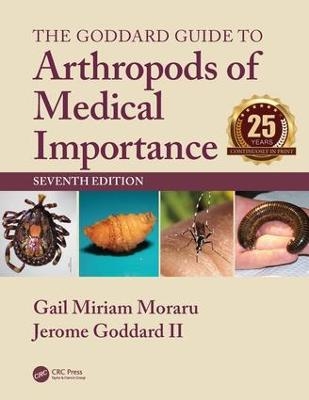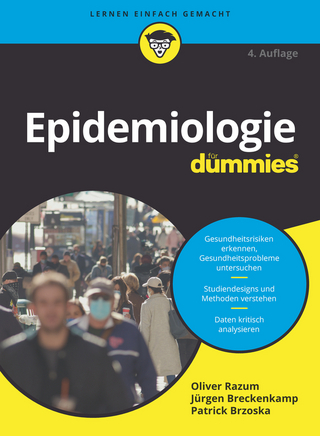
The Goddard Guide to Arthropods of Medical Importance
CRC Press (Verlag)
978-1-138-06943-5 (ISBN)
Covering all major arthropods of medical importance worldwide, this award-winning resource has established itself as a standard reference for almost 25 years. With the globilization of commerce and the world becoming more intimately connected through the everyday ease of travel, unknown arthropod species are being increasingly encountered. This means access to up-to-date, authoritative information in medical entomology has never been more important. Now in its seventh edition, this book maintains its well-acclaimed status as the ultimate easy-to-use guide to identify disease-carrying arthropods, the common signs and symptoms of vector-borne diseases, and the current recommended procedures for treatment.
Includes an in-depth chapter with diagnostic aids to help physicians to recognize and accurately diagnose arthropod-related diseases and conditions more easily
Updates all chapters with the latest medical and scientific findings, including Zika virus, red meat allergy, new viruses found in ticks, and vaccine development for malaria and dengue fever
Presents a greater medical parasitology emphasis throughout
Offers electronic downloads containing additional photographs of arthropod-caused diseases and lesions, as well as instructional videos with pest identification aids, basic entomology, and insect and pest ecology.
Illustrated throughout with detailed color images to aid identification, The Goddard Guide to Arthropods of Medical Importance, Seventh Edition will remain an essential guide for physicians, public health officials, and pest control professionals.
Gail M. Moraru is currently an instructor of biology at Linn-Benton Community College in Albany, Oregon. She obtained her Bachelor’s degree in biological science from Cornell University and her Ph.D. in Veterinary Medical Science from Mississippi State University where she studied the natural history of a novel spotted fever rickettsiosis. Subsequently, she conducted research as a post-doctoral fellow at Haifa University in Israel, looking at how natural and anthropogenic disturbances impact mosquito populations and other aquatic communities. Dr. Moraru’s second post-doctoral position was at Mississippi State University where she investigated rickettsial interference phenomena in ticks. Before coming to Linn-Benton Community College, she worked as a Senior Extension Research Associate at Mississippi State University studying Zika virus vectors throughout the state. Dr. Moraru won the Couvillion endowed graduate scholarship (parasitology), has team-taught veterinary parasitology, wildlife diseases, and several different biology and microbiology classes, and has authored or coauthored over 15 scientific publications. She is a member of the Entomological Society of America, the Southeastern Society of Parasitologists, Mississippi Entomological Association, and the Mississippi Mosquito and Vector Control Association. Her main research interests are disease ecology and parasitology. Dr. Moraru is the daughter of Jewish Romanian immigrants and grew up with her sister in California. She currently resides in Corvallis, OR with her husband and five animals. Jerome Goddard II is currently a professor of mathematics at Auburn University Montgomery (AUM), located in Montgomery, Alabama. He received a Bachelor of Science degree in Mathematics with a minor in Computer Science, and then a Master of Science in Mathematics (both) from Mississippi College in Clinton, MS. He subsequently earned a Ph. D. in Mathematical Sciences from Mississippi State University, specializing in Partial Differential Equations under the supervision of Prof. Ratnasingham Shivaji, currently a W. L. Giles Distinguished Professor Emeritus (Mississippi State University) and H. Barton Excellence Professor & Head of the Department of Mathematics (University of North Carolina Greensboro). Jerome’s research interests lie in study of nonlinear boundary value problems with nonlinear boundary conditions. These types of PDEs arise in models from population dynamics and combustion theory. Recently, his research has been externally funded by the National Science Foundation. That collaborative project between mathematicians and an ecologist is an integration of modeling of population dynamics via reaction diffusion models, mathematical analysis, and experimental analysis of an invertebrate (insect) system to explore the effects of habitat fragmentation, conditional dispersal, predation, and interspecific competition on herbivore population dynamics from the patch level to the landscape level. He has published 18 articles in peer reviewed journals and has given 60+ presentations at regional, national, and international conferences. Dr. Goddard is married to Lindsey Carpenter Goddard and, along with Millie, their daughter, they reside in Montgomery, AL. Jerome enjoys spending time with his family and outdoor hobbies including fishing, hunting, camping, hiking, and backpacking. He has an enthusiasm for teaching and research, but his true passion lies in directing student research which combines the two — mathematics and biology.
Part I Pathological Conditions Caused by Arthropods and Principles of Their Treatment 1 Principles of Treatment for Arthropod Bites, Stings, and Other Exposure 2 Allergy to Arthropods 3 Stings 4 Bites 5 Blistering, Dermatitis, and Urticaria from Contact with Arthropods 6 Myiasis (Invasion of Human Tissues by Fly Larvae) 7 Delusions of Parasitosis (Imaginary Insect or Mite Infestations) PART II Identification of Arthropods and the Diseases They Cause 8 Identification of Medically Important Arthropods 9 Clinician’s Guide to Common Arthropod Bites and Stings PART III Arthropods of Medical Importance 10 Ants 11 Bees 12 Beetles 13 Bugs (The True Bugs) 14 Caterpillars (Urticating) 15 Centipedes 16 Cockroaches 17 Earwigs 18 Fleas 19 Flies (Biting) 20 Flies (Nonbiting) 21 Flies (That Might Cause Myiasis) 22 Lice 23 Millipedes 24 Mites 25 Mosquitoes 26 Moths (Species Whose Scales or Hairs Cause Irritation) 27 Pentastomes (Tongue Worms) 28 Scorpions 29 Spiders 30 Ticks 31 Wasps (Yellowjackets, Hornets, and Paper Wasps) PART IV Personal Protection Measures against Arthropods 32 Pros and Cons of Insect Repellents 33 Arthropod-Specific Personal Protection Techniques
| Erscheinungsdatum | 20.03.2019 |
|---|---|
| Zusatzinfo | 23 Tables, black and white; 1 Line drawings, color; 105 Line drawings, black and white; 283 Halftones, color; 39 Halftones, black and white; 299 Illustrations, color; 151 Illustrations, black and white |
| Verlagsort | London |
| Sprache | englisch |
| Maße | 210 x 280 mm |
| Gewicht | 1492 g |
| Themenwelt | Sachbuch/Ratgeber ► Gesundheit / Leben / Psychologie |
| Medizin / Pharmazie ► Medizinische Fachgebiete ► Dermatologie | |
| Studium ► Querschnittsbereiche ► Epidemiologie / Med. Biometrie | |
| Naturwissenschaften ► Biologie ► Zoologie | |
| ISBN-10 | 1-138-06943-4 / 1138069434 |
| ISBN-13 | 978-1-138-06943-5 / 9781138069435 |
| Zustand | Neuware |
| Haben Sie eine Frage zum Produkt? |
aus dem Bereich


